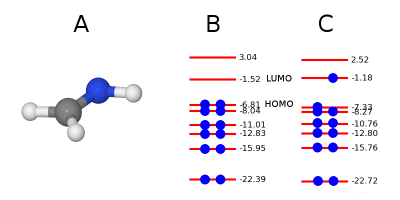This is an old revision of the document!
Constrain DFT
Constrained DFT allows to perform self consistent single electron excitation from arbitrary occupied orbital to unoccupied orbital (see example 1). There is also possibility to use quenching or geometry optimization of system in an excited state (see example 2).
Example 1
First, we show how to perform cDFT, i.e. SCF calculation of excited state, of formaldimine molecule CH2=NH. CH2=NH has in total 12 electron, from them 6 are double occupied molecular orbitals. Here we will run cDFT with a single excitation moving one electron from HOMO to LUMO state. The cDFT calculation is initiated by keywords icdft = 1. See example of fireball.in file.
Here is input file with initial geometry cnh3.bas.

fireball.in
&OPTION basisfile = CNH3.bas icluster = 1 nstepf = 1 T_initial = 100.0 T_final = 100.0 sigmatol = 0.000000001 dt = 0.01 iquench = 0 max_scf_iterations = 200 icdft = 1 &END &OUTPUT iwrteigen = 1 iwrtxyz = 1 &END &MESH &END
To move electron from one orbital to another we need to create elh.inp input file in a directory. The first line means how many electrons is in the system. The first position of the second line means number of orbital where we want to create a hole. The second position determines occupancy of the hole (between 0-1). In this case there is missing one electron in HOMO orbital. The third line first position tells where is placed excited electron, the second position means how much electron you excite. Fig.1
12 ! total number of electron 6 0.5 ! unocculied state 7 0.5 ! occupied state
Results of such calculation is on the fig[1]

